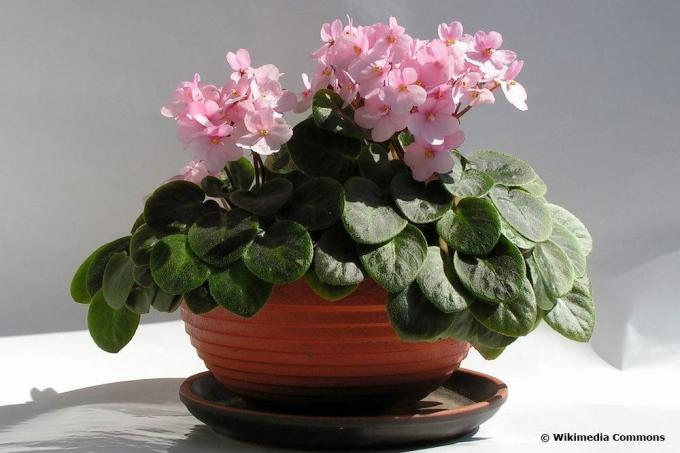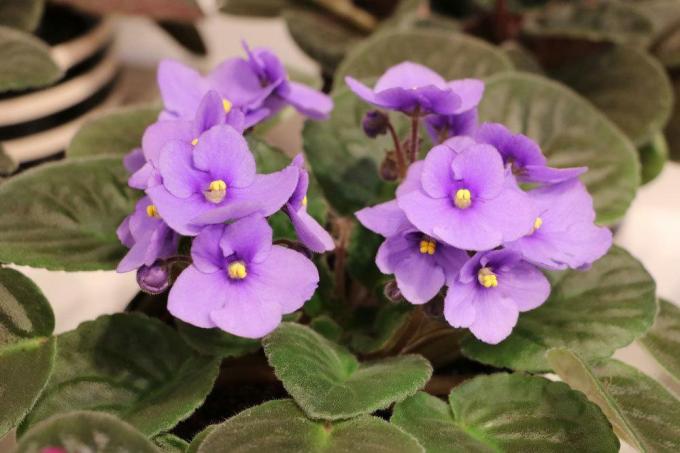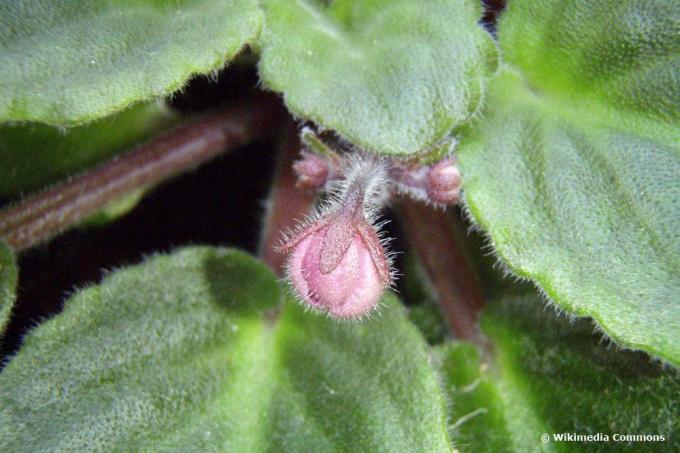
table of contents
- Characteristics
- Location
- Substrate
- Buy preferred potted plants
- Repot
- care
- to water
- Fertilize
- Cut
- Overwinter
- Multiply
- Diseases and pests
Profile and care information open +conclude -
- Flower color
- multicolored, pink, red, violet, white
- Location
- Shade, shady
- Heyday
- January, February, March, April, May, June, July, August, September, October, November, December
- Growth habit
- flat growing
- height
- up to 20 cm high
- Soil moisture
- moderately moist
- PH value
- weakly sour, sour
- Limescale tolerance
- Calcium intolerant
- humus
- rich in humus
- Poisonous
- Yes
- Plant families
- Gesneria family, Gesneriaceae
- Plant species
- Ornamental plants, Houseplants
African violets have been popular houseplants for decades as they bloom abundantly. The classic flower colors of the plants are dark purple, white and pink. Today there are around 2,000 hybrid varieties, so that no wish remains unfulfilled when it comes to choosing. The flower color today ranges from white to dark purple, with a wide variety of shades being offered. You can also choose between single and double flowers. The height of the plants including the flower is 10 to 40 centimeters.
Characteristics
- botanical name: Saintpaulia ionantha
- Plant family: Gesneriaceae
- Location: shady to shady
- Growth: cushion-like
- Flowering time: all year round
- Flower color: white, pink, lavender, dark purple, multicolored (all colors except yellow)
- Leaves: evergreen, heart-shaped
- sensitive to lime
- pH value: slightly acidic to acidic
- Use: houseplant, flower arrangement
Location

African violets should only be kept as indoor plants in this country. Even if the temperatures outside meet the requirements of the plants in summer, they are not allowed on the balcony or terrace, as they cannot tolerate temperature fluctuations. Inside they need a location with the following characteristics:
- shady to shady
- bright but without direct sunlight
- ideally a window sill (west or east side)
- Room temperature between 18 and 24 degrees Celsius
- high humidity (e.g. B. Bathroom or kitchen)
- no drafts
- no temperature fluctuations
Tip: In order for the plants to bloom abundantly and profusely, you need a location that is bright at least twelve hours a day.
Substrate
While the indoor plants are rather demanding in terms of location, they are rather modest in terms of substrate. Because normal potting soil is sufficient for them. You will make them happy if you mix them with sand or clay granules.
Buy preferred potted plants

You can get African violets in the garden center or in specialist shops as pre-grown potted plants. If you buy the houseplants in winter or when the temperatures are cooler, they must be well packed for the way home, because temperatures below 18 degrees Celsius or They don't like temperature fluctuations at all.
Repot
Since the indoor plants do not get very large, you do not have to repot the plants very often, as small pots are sufficient for them. However, thank you if you get fresh substrate every year. However, so that the pot does not become too small, you should regularly check whether the plants still have enough space. If the roots are already looking out of the drainage hole in the pot, you should repot the plants. Another indication that the pot is already completely rooted is the fact that the leaves are small or very close together.
Proceed as follows when repotting:
- ideal time: spring
- Have a slightly larger pot ready
- Fill the pot with substrate
- Carefully lift the Saintpaulia ionantha out of the old one
- Place the plant in the new pot at a distance of about a finger's breadth from the top edge of the pot
- Leaves or the leaf rosette should rest on the edge of the pot (leaves do not get wet when watering)
- Fill in the gaps with soil
care

The plants do not like changes in the care, neither in the room temperature, the watering or the light conditions. Only when fertilizing is it allowed to change the dose. This allows you to reduce fertilization if you want to give the plants a winter break. Because for a lush bloom, they need additional nutrients.
to water
Make sure that the substrate is always evenly moist. As with room temperatures, the plants do not like fluctuations in the water balance. Ideally, you water the African violet when the top layer of the substrate is slightly dry. Since it does not tolerate lime, ideally you should use rainwater for watering. If this is not possible, it is best to use lime-free water. You should also make sure that the irrigation water is not too cold, because the African violet does not like this either. Lukewarm, stale water is ideal.
The African violets are best poured from below. Therefore, you do not get a planter, but a trivet that makes watering easier. Alternatively, you can lift the plants out of the planter for watering and place them in a saucer filled with water for watering.
Tip: African violets may like warm feet, but they don't like wet feet at all. Waterlogging can even cause the plants to die.
During the watering process, the leaves of the plants must not be wetted or get wet as there is a risk that they will start to rot. This is why you shouldn't spray the plants despite their high need for humidity. If the air has too little moisture, for example above the radiator, it is best to place a small bowl with water next to the plants. If dust settles on the leaves, you should not remove it with a damp cloth, but with a brush.
Fertilize

In order for Saintpaulia ionantha to bloom profusely and permanently, it should be fertilized regularly. A liquid fertilizer that you give about every three weeks is ideal. The plants do not need a blooming break.
Cut
African violets cannot and do not have to be cut. If you find a rotten or dried up leaf on the plants, tear it off with a slight jerk. In no case should the scissors be used. When tearing up, make sure that no stubs remain, as these can lead to rot and consequently to the death of the plants.
Overwinter
African violets do not need classic wintering. It is important that the room temperature does not fall below 18 degrees even in winter. If you want to give the plants a short (flowering) break, then you should reduce or reduce the amount of fertilizer. adjust slowly.
Multiply

Leaf cuttings are ideal for propagating African violets. However, only strong plants should be used as mother plants for this purpose. You can take a leaf from the mother plant every four weeks to reproduce, so it is not damaged by the loss of leaves. However, you should change the mother plant after two years at the latest. If you only want to grow a few new plants, proceed as follows:
- Tear off the leaf from the mother plant (number of leaves as required)
- Put one leaf at a time in a pot with a mixture of sand and peat
- Insert the leaf into the mixture up to the edge of the leaf
- Keep the substrate slightly moist
Tip: The leaf cuttings take root best at a temperature between 24 and 27 degrees Celsius. And here, too, the rule is that the temperature should not fluctuate.
After about six weeks, small new leaves should have formed next to the leaf that you tore off the mother plant.
If you want to breed a whole colony of new African violets, put the individual leaves in a large container. They stay there, lined up, until new leaves have formed. In this case, too, this takes about six weeks. Since the cultivation vessel is now too small for the colony, the new African violets are carefully plucked apart and put into individual pots.
Tip: In order for Saintpaulia ionantha to develop well, there is only one young plant in each pot.
Propagate in a glass of water
When propagating in a water glass, the torn off leaf of the mother plant is placed in a glass with lime-free water. It is important that the edge of the leaf does not come into contact with the water. With this type of propagation, you should see the first roots after two to three weeks. Once roots have formed, the young African violets can be moved into pots (one young plant per pot).
Diseases and pests
If the plants get too much sun, the leaves become yellow-spotted or yellow-tinged. In this case, you should immediately take the plants out of the sun and give them a more shady spot. Too much water, even if it is well meant, harms the plants. In the worst case, the roots start to rot, which ultimately leads to the plant dying.

Rescuing the African violet is difficult, but you can try to keep it dry. That means they'll move it to dry substrate after you've removed all of the rotten roots. If the plants get too little water, the leaves will also change color. In addition, they also turn yellow if the location offers the plants too little humidity. If almost no flowers form, the African violet is too dark or does not receive enough nutrients.
Pests
Most often, Saintpaulia ionantha is attacked by thrips as well as aphids and mealybugs. If you discover an infestation with these pests, you should act quickly. But be careful, the sensitive leaves do not tolerate spraying with agents, including household remedies, against the pests. Therefore, to protect the plants, you should use agents that you can stick or work into the substrate, such as sticks or powder. Natural predators also help against the pests.
The African violet has no chance of survival if it is infected with small leaves (nematodes). This is shown by glassy and give leaves. If you discover an infestation, you should remove the plant immediately and dispose of it in the household waste, so that this pest at least does not spread to the other plants.



